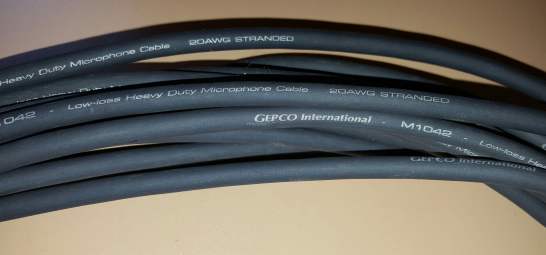
Duh! No one ever told me.
v 0.1 Aug 24, 2016
Professionally speaking, audio wires can be divided into three basic categories. Microphone, line, and speaker cable.
In most cases they are not interchangeable. Should you substitute one for another, you can get unsatisfactory results.
Microphone wire or cable are typically balanced. Meaning the audio signal appears on two wires and is covered with a ground shield. Good wire may be identified by the writing on the cable as shown below.

Most have what is called an XLR connector on each end.
Older style cables and older microphones such as ceramic or crystal elements can be unbalanced and will suffer noise and hum problems. These microphones and cables were popular from the 1940's thru the 1960's. They have all but disappeared by now except for antique and legacy systems. A group of microphone cables can be bundled together to go from a stage to the mixer in the rear of an auditorium or sanctuary. This is called a snake and can be in lengths of 50 to 150 feet.
Balanced cables as stated have two conductors and a shield. Unbalanced cables have only one center conductor and a shield. To understand more about balanced and unbalanced view this page: Understanding Balance and Unbalanced.
Instrument cables are typically unbalanced. These cables are used for electric guitars, keyboards, effects boxes, and patch cables used to connect mixers to external effects, preamps, and amplifiers. They are sometimes called TS for Tip/sleeve and have 1/4 inch plugs on each end. For more professional use they could be balanced TRS type.
Speaker cables are two conductor wires, usually a heavy gauge such as #14, #12, or #10 gauge. Most cables have black and white insulation on the wires. The cable is not shielded and usually have a rubber jacket. Better cables are marked "speaker wire".
All three types should not exceed 25 or so feet long otherwise losses can be had.